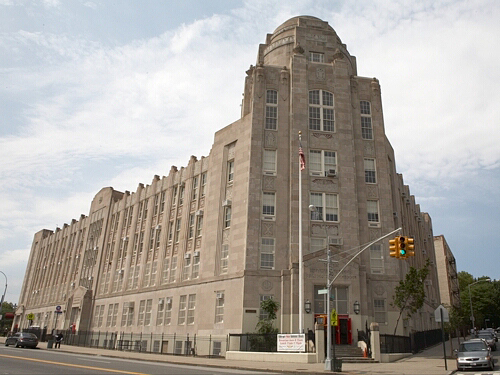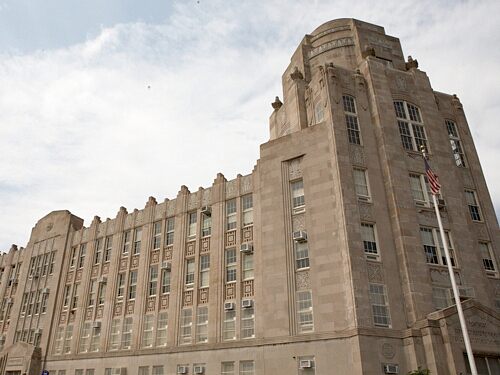Herman Ridder
Junior High School/P.S. 98

Boston Road and East 173rd Street
Walter C. Martin
1929-33
In September 1929, the new Superintendent of School Building Walter C. Martin, announced plans to build New York’s “first thoroughly modernistic school building.” Timid attempts had recently been made to apply geometric brickwork or angular sculpted figures to schools. But thoroughly modern Ridder Junior High School, like the newest buildings of Manhattan, aspired to give structural expression to one currently popular “modernism,” Art Deco.
Martin, like most school engineers, preferred buildings with long flat walls with unobstructed space for classroom windows. Ridder has two such classroom wings, which, making the most of a difficult site, meet in an acute angle on the corner of Boston Road and 173rd Street. For these brick façades, the graphic, low-relief designs of Deco are ideal. Alternating piers and ribs terminate in zigzag cresting which gives the cornice-less roof line its silhouette. Between the piers, double windows form columns, the intervening spandrels set with ornamented terracotta panels (fine floral ones at the roof) and polychrome brick. At the ends of the wings, entrance pavilions are marked by limestone enframements carved into the characteristic Deco motif of overlapping receding planes. The same stepped-back pattern appears on the jambs of the auditorium doorway, and (in brick) on the piers that form the window bays.
Flat walls and sharp outlines, however, give Ridder’s façades the feeling of paper cut-outs. Art Deco (named for an exposition of Arts Decoratif) was by nature a style of ornament, literally superficial, and architecture was only gradually finding ways of realizing its exciting shapes in solid volumes. Ridder’s solution is startling: a thick, tall exclamation point of an entrance tower that cuts across the vertex where the wings converge. In manner and material, the tower is in effect an independent structure. It rises straight up, a rectangular limestone block, following two wide piers on its face to a parapet at the fifth story. At this level, inducing a pause, heroic-sized sculpture appears —pilasters terminate in elongated maidens displaying books, stone urns rest on the ledge above the piers. Then, above the parapet, the tower abruptly changes shape, ending in a series of concentric cylinders, gradually flattened and terraced like a Babylonian ziggurat.
It takes a few minutes to recognize that this spatially complex, wonderfully theatrical tower, so different from the adjoining wings, is in fact their logical visual climax. Its massive stone piers are exaggerations of the vertical brick ribs, its figurative acroteria developments of the abstract roof cresting. The crowning ziggurat is the master form, a monumental restatement of Deco’s nervous zigzags.
Ridder wasn’t the last word in Bronx Deco. The well-known apartment houses of Grand Concourse and Pelham Parkway by Horace Ginsbern and others took the style through further phases. In the 1980s, the first new office building in many years, Skidmore, Owens and Merrill’s retro Fordham Center, took the form of an homage to the borough’s history of Deco, adding a smooth “streamline” wraparound of glazed brick to unmistakable recreations of the signature corner angle and terraces of Martin’s school.
David Bady
Photographs:
Abigail McQuade





